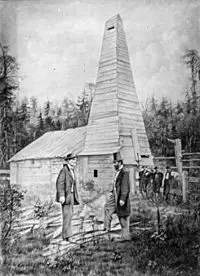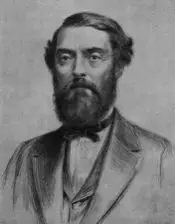How did Edwin Drake create the World's first oil well
Even though there was no one "first discover" of oil. Oil was known in antiquity when it was used to heal wounds. But by the middle of the 19th century methods for collecting oil from the ground had not changed for thousands of years. Edwin Drake's oil fundamentally changed this process and dramatically increased oil production around the world. Instead of harvesting oil in a pail or sopping it up with rags and wrung out by hand over barrels, oil wells produced thousands of barrels of oil. The creation of the oil well fundamentally altered the course of the 20th century. [1]
The Need for Cheap Indoor Illuminants
The future of oil changed in 1846. Abraham Gessner, who was trained as a physician in England but spent his life in geological work in his native Canada instead, was performing public lectures in Charlottetown, Prince Edward Island. During one demonstration Gessner showed how oil distilled from bituminous coal could be used to light a lamp. He called the distillate "kerosene" and those in attendance that day were on hand for the birth of the oil refining industry.[2]
Indoor illuminants at the time relied on whale oil which was, of course, difficult and dangerous to obtain and expensive - $2.50 a gallon at a time when a good day's wage was less than one dollar.[3] Kerosene burned smokily and smelled awful but tinkerers soon discovered that a lamp with a glass chimney solved both problems. Finding petroleum for these proliferating cheap "kerosene lamps" stoked the fire of the day's entrepreneurs.
Enter a Visionary
George Henry Bissell was not one of those obsessed with kerosene. Rather, in 1853 he was a 32-year old struggling lawyer when he saw samples of "rock oil" from western Pennsylvania on the campus of Dartmouth College in his hometown of Hanover, New Hampshire. When he saw how readily the inky black liquid burned Bissell immediately saw its potential as an illuminant and not as a medicinal salve. Furthermore, it became Bissell's plan to drill for the oil in a way that salt had been obtained for hundreds of years.
Bissell commissioned a report from one of the leading scientists of the day, Benjamin Silliman, Jr., to verify the energy potential of rock oil and began making the rounds in New York City to convince investors in his scheme. There were not many takers in the Pennsylvania Rock Oil Company. Bissell's partner James Townsend reported after one pitch that the naysayers chided him: "Oh, Townsend, oil coming out of the ground, pumping oil out of the earth as you pump water? Nonsense! You're crazy.”[4]
The Dream Comes Together
Bissell and Townsend trundled on, spewing their plans for most anyone who would listen. One who listened and was intrigued enough to buy a few shares in the enterprise was Edwin Drake, who lived in the same hotel as Townsend. Drake, it was decided, would be the man to helm the first drilling project. At thirty-eight years of age, he boasted no special training and no experience. He had worked for the railroad as a station clerk and a freight agent and a conductor but had been forced to retire due to infirmity.[5] Drake's main qualifications as a drilling engineer were, one, that he was available and, two, his lifetime railroad pass enabled him to ride back and forth to Pennsylvania for free. That was no small consideration for the newly renamed Seneca Oil Company.
Drake's train pulled into the flea speck town of Titusville, population 150, in the spring of 1858. Jonathan Titus was a surveyor with Samuel Kerr for the Holland Land Company in 1800 when the men bought up land and platted a townsite.[6] Lumber was the prime economic engine but the surrounding hillsides were quite nearly stripped bare by mid-century and when the timber was gone it was expected that Titusville would soon be as well.

Bissell had taken to referring to Drake as "Colonel" in correspondence sent to Pennsylvania, although the closest Drake had ever come to the military was punching soldiers’ tickets on the train. In doing so Bissell hoped to provide Drake some agency among the workers in the hardscrabble backwoods and that authority indeed proved useful in recruiting fresh crews as "the Colonel" failed in one drilling attempt after another. The townsfolk took to calling the operation down on Oil Creek "Drake's Folly."
Perseverance, Redemption and Success
He tried a steam engine but the soft sand in the stream continually collapsed around his shaft. With each grim report dispatched to Bissell's office in New Haven, Connecticut the investors clenched the purse strings a little tighter. But what Edwin Drake lacked in technical expertise he more than made up for in the quintessential American trait - stick-to-itiveness.
Drake overcame the obstacle of the collapsing oil seeps by driving an iron pipe down into the earth and drilling inside it - a technique that the modern petrochemical industry uses today. When he reached bedrock and still no oil was found Drake borrowed money from his friends to keep drilling when funds from Seneca Oil was slow to arrive. Finally, on August 27, 1859, at a depth of 69 feet, history's first oil well came in.[7]
The world had never seen anything like what happened next. Derricks sprouted along Oil Creek within days. The word "boomtown" was coined to describe the settlements that swelled to over 10,000 residents in weeks. Bissell sped towards Titusville and bought up every farm he could find for Seneca Oil. Within a year there were more than 75 wells producing oil in western Pennsylvania - enough crude to spark the construction of full-blown refineries.
Boom…then Bust
While certainly exciting, those initial wells were modest affairs by today's standards. The oil was still pumped out of the ground each time it was discovered. But 30 months after Drake's first well the world's first "gusher" came in, with oil literally exploding from inside the earth. Production soon spiked to over three million barrels a day from barely half a million barrels. The glut sent prices spiraling for $10 a barrel to 50 cents.[8]
The crash ruined speculators, one of whom was Edwin Drake. George Bissell held on through the crisis and emerged a wealthy man when prices rebounded and new uses for petroleum were discovered. Drake also had never bothered to patent his oil drilling technique. He spent the last years of his life reduced to writing friends to beg for money. In 1873, as he lived out his final days in infirmity, the state of Pennsylvania eased his troubles by issuing him a small lifetime pension in recognition of his contributions to the development of Keystone State industry.
As it turned out, Drake had been extremely lucky in choosing his drilling spot on a small island in Oil Creek. If he had sunk his iron pipe just a few feet to the left or to the right it would have required another 100 feet of perseverance and funding to strike oil. But the question of whether Edwin Drake had enough remaining of either does not need to be asked.
While others around him were cashing in fortunes after his discovery on Oil Creek, Drake was more concerned with securing his legacy in some of his last writings: "I claim that I did invent the driving Pipe and drive it and without that they could not bore on bottom lands when the earth is full of water. And I claim to have bored the first well that ever was bored for the Petroleum in America and can show the well. If I had not done it, it would have not been done to this day.”[9]
References
- Jump up ↑ American Chemical Society, “The Development of the Pennsylvania Oil Industry,” 2009.
- Jump up ↑ University of Toronto and Université Laval, " Dictionary of Canadian Biography, (Toronto: University of Toronto Press, 1959).
- Jump up ↑ Yergin, Daniel, The Prize: The Epic Quest for Oil, Money & Power, (New York: Free Press, 1991).
- Jump up ↑ Giddens, Paul H., The Birth of the Oil Industry, (New York: The MacMillan Company, 1938), p. 48.
- Jump up ↑ Dav, Urja, “Edwin Drake and the Oil Well Drill Pipe,” 2008.
- Jump up ↑ Weber, David L., Images of America: Around Titusville, (Charleston, SC: Arcadia Press, 1994).
- Jump up ↑ American Chemical Society, "The Development of the Pennsylvania Oil Industry," 2009.
- Jump up ↑ Yergin, Daniel, The Prize: The Epic Quest for Oil, Money & Power, (New York: Free Press, 1991).
- Jump up ↑ Yergin, Daniel, The Prize: The Epic Quest for Oil, Money & Power, (New York: Free Press, 1991), p. 26.


